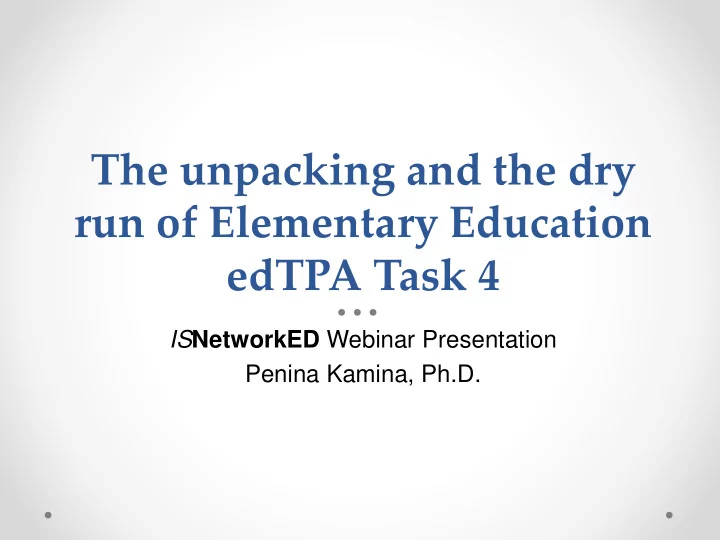

The unpacking and the dry run of Elementary Education edTPA Task 4 IS NetworkED Webinar Presentation Penina Kamina, Ph.D.
Terms, Meanings, Examples Conceptual Understanding Procedural Fluency Meaning and relationships of Rules, procedures, algorithms, concepts symbols Place Value Long multiplication Patterns of Learning Problem Solving Mathematical Reasoning Solving a non-routine problem Make sense, prove, justify, logical Write a word problem for which thinking/examination/explanation, 25kg 32g – 23kg 83g = ?, would be critique the solution equation. Smart by Shel Silverstein
Assessment for Whole Class • Write, adapt or adopt an assessment with 3-4 dimensions of mathematical understandings • Writing an evaluation criteria • Score - Feedback, grade
Before Dry Run: Task 4 Math context for learning • (max. of 3 Arial 11-pt single- spaced pages with 1” margins) Confidentiality and professionalism o Demographics – district, school, class, curriculum, socio-norms of the class, expectations of o cooperating teacher Math learning segment • (max. of 2 Arial 11-pt single-spaced pages with 1” margins) State content standards o Central focus o 3-5 lessons o Learning objectives, Instructional strategies, learning tasks, formative and summative assessment o Commentary • (max. of 8 Arial 11-pt single- spaced pages with 1” margins) Teacher candidate takes full responsibility o Is in charge o There are four prompts thus four commentaries to write but three rubrics o Artifacts • (No page number limitations) One blank whole class assessment and evaluation criteria o Three student work samples from whole class assessment o Three student work samples from re-engagement lesson o File type to use for Task 4 are .doc, pdf, .docx or .odt
After Dry Run: Task 4 Review four parts of prompt 1 commentary & rubric 16. • Whole class assessment based content of the 3-5 lessons; standards and objectives; evaluation criteria; scored; analyzed quantitatively and qualitatively Artifact: blank copy of • Patterns of learning of class wrt the 3-4 math understandings (CU, PF, MR/PS) assessment Review prompt 2 commentary & • Write one math area of struggle . Choose 3 students’ work sample with the same struggle rubric 17. Artifacts: 3 students to support and provide evidence. One of these students must have a learning need work samples from whole-class • Cite each; explain and elaborate; relate & connect impact of math struggle to big math ideas assessment Review the five bullets of prompt • Plan a lesson (write objective(s) of lesson aligned with area of identified math struggle). 3, prompt 4 and rubric 18. Teach, assess and collect a written work of the 3 focus students at the end of the lesson. • Were the strategies effective/ineffective? Cite evidence from each focus student work, Artifacts: 3 students work samples explain and elaborate. Make an overall evaluation; change in student math understanding or misconception. from re-engagement lesson
Work Cited Barlow, A. T. & Harmon, S. (2012). CCSSM: Teaching 3 and 4. Teaching Children Mathematics , • 18(8), 498-507. Bleiler, S. K. & Thompson, D. R. (2012). Multidimensional assessment of CCSSM. Teaching Children • Mathematics , 19(5), 292-300. Burns, B. & McKissic, T. (2013) Understanding NYS edTPA elementary education task 4: • Mathematics, Video, Retrieved on March 24, 2014 from, http://vimeo.com/79674183 Dacey, L. & Polly, D. (2012). CCSSM: The big picture. Teaching Children Mathematics , 18(6), 378- • 383. edTPA Elementary Education Handbook, http://edtpa.aacte.org/ • edTPA for New York State, http://www.nystce.nesinc.com/NY_annTPA.asp • Engage New York, http://www.engageny.org/mathematics • Islas, D. (2011). How to assess while you teach: Formative assessment practices and lessons, • grades K-2. J. A. Cross (Ed.) Multimedia Professional Learning Resource. Sausalito, CA: Scholastic Inc. Lamberg, T. (2013). Whole class mathematics discussions: Improving in-depth mathematical • thinking and learning . Boston: Pearson Education Inc. National Research Council. (2001). Adding it up: Helping children learn mathematics. J. • Kilpatrick, J. Swafford and B. Findell (Eds.) Mathematics Learning Study Committee. Center for Education, Division of Behavioral and Social sciences and Education. Washington, DC: National Academy Press. New York State P-12 Common Core Learning Standards for Mathematics (2011). • http://www.p12.nysed.gov/ciai/common_core_standards/pdfdocs/nysp12cclsmath.pdf
Recommend
More recommend